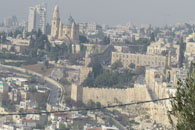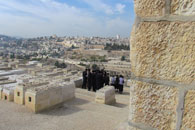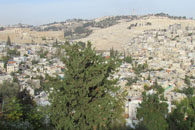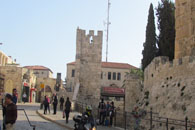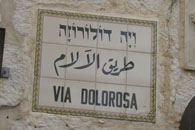PILGRIMAGE TO THE HOLY LAND
October - November 2014, I had the chance to travel to Israel for a pilgrimage. As this trip corresponded to my annual vacation, I took the opportunity of visiting friends in Belgium, the Ursuline Sisters in Koenigstein, a convent at 15 miles from Frankfurt in Germany, where I studied German, as well as I visited my nephew, Jean Claude, in Ancona, Italy.
For a long time, I yearned to go to Israel, but I never had the opportunity to do so. This time, thanks to my friend Fr. Paul Vanderbeke, the director of pilgrimages for the diocese of Brussels, a window opened up for me to join a group of 46 other people from Belgium, Luxemburg and France, for the pilgrimage.
All started with a flight of 4 hours and 27 minutes from Brussels to Tel Aviv. After 2 hours of driving South of Israel, we came in the desert of Negev where we spent the night in the kiboutz of Mashabe Sade.
Continuing south, we came to Ein Avdat where the tombs of Paula and David Ben-Gurion are located, close to the great crater of Hamachtesh Hagadol before spending the night in Arad. This step of the trip gave us the chance of discovering the well of Abraham in Beersheba where he made a pact with Abimelech and where also Jacob had a dream (Gen 28: 10-15; 46: 1-7).
Going east, we came to the Dead Sea with its desalination and evaporation pools. Here, one can see from afar the buildings in Jordan. The interest of this step was to see the Dead Sea and the archeological site of Qumran in the Judean desert where the ancient scrolls dating 100 BCE were discovered hidden in the caves.
Besides Qmuran, we visited also Ein Gedi, a source of water in the desert, close to the Dead Sea, where, David spared Saul’s life (1 Sam. 24). From there, we drove to the Jordan River, shared by Israel and the Kingdom of Jordan, in order to see the site of the baptism of Jesus (Mt 3: 13-17; Mk 1: 9-11; Lk 4: 21-22) at Al Maghtas.
From there, we spent the night in the Palestinian territory in the city of Jericho where we discovered the sycamore tree (Lk 19: 1-10) and the mountain of Jesus’ temptations (Mt 4: 1-11; Mk 1: 12-13; Lk 4: 1-13). Driving north to Nazareth, we made a stop in Samaria (Nablus) in order to see the well of Jacob (Jn 4: 4-42). The well currently lies within the complex of an Easter Orthodox monastery of the same name, in the city of Nablus in the West Bank.
The discovery of Nazareth was quite moving with the visit of the tomb of the just (St Joseph) in the convent of the sisters of Nazareth, the Basilica of the Annunciation (Lk. 1: 26-36), the Synagogue Church (Lk. 4: 16-24), the Mountain of Precipice (Lk. 4: 29-30), the Greek orthodox Church of St Gabriel within which lies the well where the Blessed Mother was used to drawing water in the village.
I took also the advantage in visiting the convent of the little brothers of Jesus who have inherited an old convent of Clarisse sisters where Charles de Foucauld stayed for three years in imitation of Jesus, from 1887-1900.
From Nazareth, we drove to Cana to see the site of the transformation of water into wine (Jn 2: 1-12). That night in Nazareth, we had the chance of hearing a conference given by Fr. Emile Shoufani, an Israeli Arab Christian, a Melkite Greek catholic Priest, a peace activist and theologian, who works for the reconciliation of the Jews and the Arabs.
On the following day, we went north at the border with Lebanon to visit the sources of Jordan river in Banias or Caesarea Philippi (Mt 16:13-19), situated 25 miles north of the Sea of Galilee at the base of Mount Hermon. At Caesarea Philippi stood the ruins of an ancient temple dedicated to Caesar August. We finished the day at Mountain Tabor, the site of the transfiguration of our Lord (Mt 17:1-13; Mk 9:2-9; Lk. 9:28-37; 2 Peter 1:16-18) where we celebrated the Holy Mass in the Basilica of the transfiguration.
The following day we drove to the beautiful Sea of Galilee, from where Jesus’ mission started (Mt 4:12-25; Mk 1:14-20; Lk 4:14-15). The Sea of Galilee is also called the Lake of Tiberias or the Lake of Gennesaret. It has a circumference of 33 miles and is 13 miles long and 8.1miles wide. If within 2000 years Israel has changed a lot in terms of demography, landscape and life of the people, the Sea of Galilee, on the contrary, remains the same. It is a silent witness of the events of our salvation.
At the Lake of Galilee one finds what is called the Holy triangle, namely the Mount of Beatitudes (Mt 5:1-12), the site of the multiplication of bread (Jn 6:1-15) at Tabgah and Capernaum at the northern shore of the lake (Lk 4:31-37, 38-39; Mk 1:21, 35), the village of Jesus (Mk 2:1-2). The Lake of Galilee is also the scene of the apparition of our Lord after his resurrection from the dead (Jn 21:1-14). Near the Lake is erected a chapel called of primacy where our Lord has made Peter a rock on which he builds his church. Another church built near Capernaum is said to be the home of St Peter (Mt 8:14-15; Mk 1:29-31; Lk 1:29-31). There stand the ruins of the ancient Synagogue that our Lord might have used in his time. We called the day off with the crossing of the Lake in a ship by listening to the text of Mark 4: 1-9, 35-41).
After the stay in Nazareth, we drove to Bethlehem, in Palestinian territory, where we logged in the guest house of the Sisters of Charity of St Vincent de Paul. That night, we had a talk given by sister Laudi, a French-Lebanese, explaining the many difficulties the nuns have in taking care of an orphanage in the Palestinian territory. Before going to the convent, we stopped at Bethlehem Wood Shopping Center, where Palestinian Christians sell arts and crafts they made for living.
The interest of Bethlehem was to see the site of the birth of Jesus which is in the grotto complex within the Basilica of Nativity and the field of Shepherds from where rung the songs of the angels. By entering Bethlehem one can see easily the electric fence and the wall of separation that Israel has erected in order protect its territory against Palestinians. On the last day of the stay in Bethlehem, we visited a Palestinian refugee camp of Aida in order to see with our own eyes the complex situation of the difficult relationships between Israel and Palestine. Dr Abdelfattah instructed us on his foundation that works for peace and the rights of Palestinians.
The two last days of the pilgrimage were dedicated to Jerusalem. As we entered Jerusalem, we listened to the Psalm 122 that the pilgrims were singing in seeing the city of God. The discovery of Jerusalem started with a visit to the Auxiliary Bishop of the Latin Patriarchate of Jerusalem who talked to us about the challenge of Christian churches in the Holy Land and the difficult political situation to which they are confronted on a daily basis.
After that, we visited the museum of Shoah at Yad Vashem, downtown Jerusalem, the mascot of the city of Jerusalem at the time of Jesus and the manuscripts of Dead Sea in the museum of the book, near the Knesset, the Israeli Parliament. It was also an occasion to discover the Mount Zion and the Cenacle where Jesus had the last supper with his disciples (Mt 27:69-75; Mk 14:66-72; Lk 22: 14-20) and the Church of St Peter en Gallicante remembering Peter’s denial of Jesus (Lk 22:33-34).
After a peaceful night at Latin Patriarchate of Jerusalem, we opened up the day with the visit to the Mount of Olives on the ridge east of the ancient city of Jerusalem (Mt 21:1; 26:30). At the foot of the Mount of Olives lies the Garden of Gethsemane where our Lord was in agony before his arrest (Mt 26:36-46). At the same place a church is built at the site where our Lord wept over Jerusalem ([Dominus flevit super illam] Lk 19:4-44). The Jewish cemetery is near the Mount of Olives. There is very close to that place one of the gates of the ancient city of Jerusalem which is completed sealed. The Orthodox Jews believe that when the Messiah will come, it will be by at that gate.
At the Mount of Olives is also the church of the nations where one finds the “Our Father” in all the possible languages of the world. It is believed that it was there that Jesus taught his disciples how to pray (Lk 11:1-4).
In the afternoon of that day, in our way to the Wall of Lamentations or Western Wall, we went on foot at the discovery of the bazaar of Jerusalem with all its different quarters (Jewish, Muslim and Christian). After the visit of the bazaar, we stopped to the ruins of the Pool of Bethesda that had the virtue of healing (Jn 5:1-18). The Pool is in the Muslim Quarter and within the complex of the Church St Anne. From there we followed the traditional Via Dolorosa, by doing the way of the cross in the footsteps of Jesus until the Golgotha. The crowning of the day and the visit of Jerusalem was the celebration of the Holy Mass at the Church of St Sepulchre, where our Lord was buried and from there he rose from the dead. The grotto where they laid him is very visited.
In our way to Tel Aviv for the return to Brussels, we celebrated the last Mass in the Holy Land in Emmaus (Lk 24: 13-35) with another group of pilgrims from the Diocese of Arras in France. The Mass took place in the Benedictine Abbey of Abu Gosh.
Enjoy some pictures from the pilgrimage.
Click twice any picture to see a large version
It was so difficult to select only fifty pictures from a thousand that a separate section on Jerusalem and Emmaus was necessary
 Interior yard of Ursuline Sisters cloister in Koenigstein, Germany
Interior yard of Ursuline Sisters cloister in Koenigstein, Germany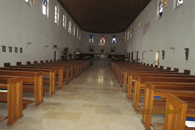 Chapel of Ursuline Sisters
Chapel of Ursuline Sisters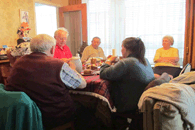 With friends in Brussels
With friends in Brussels With grand niece, Samantha, in Italy
With grand niece, Samantha, in Italy Kiboutz of Mashabe Sade in the desert of Negev
Kiboutz of Mashabe Sade in the desert of Negev River in the desert after the rain
River in the desert after the rain View of the desert of Negev
View of the desert of Negev Wild sheep resting under the tree
Wild sheep resting under the tree Tombs of Paula and David Ben-Gurion in the Negev
Tombs of Paula and David Ben-Gurion in the Negev Mass in the ruins of Nabatean City from V century in Avdat
Mass in the ruins of Nabatean City from V century in Avdat Well of Abraham in Beersheba
Well of Abraham in Beersheba View of Beersheba, admnistraive capital of Negev
View of Beersheba, admnistraive capital of Negev Ein Gedi, place of encounter between David and Saul
Ein Gedi, place of encounter between David and Saul One of the Grottos of Qmuran
One of the Grottos of Qmuran River Jordan & Site of Jesus' Baptism at Al Maghtas
River Jordan & Site of Jesus' Baptism at Al Maghtas Israeli soldier at the River Jordan
Israeli soldier at the River Jordan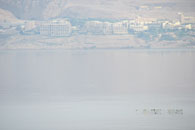 View of Dead Sea & Buildings from the Kingdom of Jordan
View of Dead Sea & Buildings from the Kingdom of Jordan Sycamore tree in Jericho
Sycamore tree in Jericho Mount of temptation in Jericho
Mount of temptation in Jericho Resort Village in Jericho
Resort Village in Jericho View of Israeli electric fence & colony in Cisjordan
View of Israeli electric fence & colony in Cisjordan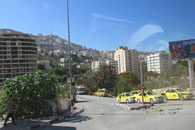 View of the City of Samaria
View of the City of Samaria  Well of Jacob in Samaria
Well of Jacob in Samaria Mass at St Justin Latin Church in Samaria or Nablous
Mass at St Justin Latin Church in Samaria or Nablous In the chapel of the Sisters of Nazareth
In the chapel of the Sisters of Nazareth Tomb of the just in the Convent of the Sisters of Nazareth
Tomb of the just in the Convent of the Sisters of Nazareth Chapel where C. De Foucauld spent his life in Nazareth
Chapel where C. De Foucauld spent his life in Nazareth Basilica of Annunciation in Nazareth
Basilica of Annunciation in Nazareth Inside Synagogue Church where Jesus Preached in Nazareth
Inside Synagogue Church where Jesus Preached in Nazareth Nazareth seen from the Mount of Precipice
Nazareth seen from the Mount of Precipice Sunset from the Mount of Precipice
Sunset from the Mount of Precipice Source of Jordan River in Banias or Cesarea Philippi
Source of Jordan River in Banias or Cesarea Philippi Mount Hermon at the borders with Lebanon
Mount Hermon at the borders with Lebanon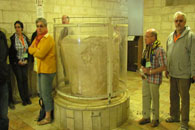 Preserved Jar of water beneath the Church of Caana
Preserved Jar of water beneath the Church of Caana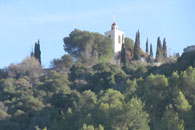 Basilica on the Mount of Transfiguration
Basilica on the Mount of Transfiguration Mass inside the Basilica of Transfiguration
Mass inside the Basilica of Transfiguration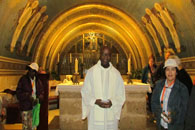 Inside the Church of Transfiguration
Inside the Church of Transfiguration Lake of Galilee or of Tiberias
Lake of Galilee or of Tiberias A lost stone at the Lake of Tiberias
A lost stone at the Lake of Tiberias Mass at the site of Peter's Primacy at the Lake of Tiberias
Mass at the site of Peter's Primacy at the Lake of Tiberias Inside the Church of the multiplication of bread
Inside the Church of the multiplication of bread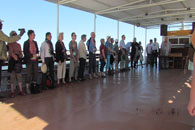 Crossing of the Sea of Galilee in a ship
Crossing of the Sea of Galilee in a ship Sunset of the Sea of Galilee
Sunset of the Sea of Galilee Entrance to the ruins of Capernaum
Entrance to the ruins of Capernaum Ruins of the town of Capernaum
Ruins of the town of Capernaum Basilica of Nativity in Bethlehem
Basilica of Nativity in Bethlehem Inside the grotto of nativity
Inside the grotto of nativity Entrance of the field of Sheperds
Entrance of the field of Sheperds








 Church of the nations, site of the prayer of "Our Father"
Church of the nations, site of the prayer of "Our Father"

